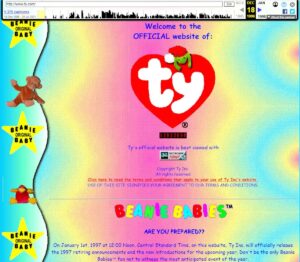We’ve come a long way since the early 2000s wasteland that was Craiglist ads and Geocities home pages. Although there’s nothing quite like perusing past the “Missed Connections” ads on your way to listing your handmade inventory of child-safe car tags in the “For Sale” section…

…if your site still hasn’t moved past a one-page deep Geocities homepage, then it’s time to consider an upgrade.

E-commerce is the wave of the future, and these platforms play a vital role in the success of online businesses, providing the necessary tools and infrastructure to set up and manage an online store.
Choosing the right e-commerce platform is crucial for businesses looking to establish a strong online presence and effectively sell products or services. There’s literally nothing worse than having customers lose trust in your business due to a shoddy or malfunctioning shopping experience. So, let’s delve into the pros and cons of some of the most widely used e-commerce platforms around so you can make an informed decision that aligns with your business’s needs.
But more specifically, this post might come off as dry or boring, and honestly, it just wasn’t holding the copywriter’s attention long enough to write the remainder of it.
So what better way to hold middle America’s viewing attention together for three-plus hours and a post-credit sequence than by giving this blog post a Marvel movie makeover? Time to get allegorical, folks!
So let’s throw some money at this baby, overwork our visual effects team for minimum wage, slap a green screen behind a Walmart parking lot, and pull up our finest spandex suits…. because this blog post just got James Gunn fired, rehired, and underwent several script rewrites before being re-filmed twice!
Welcome to “E-Commerce: The Shopping Sanctum of Insanity Pt. 3,” where everything is one big, uncomplicated allusion to a Marvel movie, and no one ever really dies.

Let’s find out more about our ragtag team of e-commerce misfits who band together to save the world and universe, and the multiverse, the megaverse, and the megamonolithaverse… or, you know, the platforms that help customers to buy more things.
Shopify: The Rich A-Hole of E-Commerce

Shopify is the most well-known platform of the e-commerce roster, and if it had to be a Marvel superhero, it would definitely be the Tony Stark of the bunch, considering it rakes in bookoo bucks on the daily. Perhaps the sleekest and most integrated of the gang, it also knows it’s being paid more than the other cast members, so prepare to listen to its shpiel (and also shell out more dough to use it).
Pros:
- Like Tony Stark’s suit, Shopify is sleek, stylish, and packed with advanced features that give your store a superhero edge, but it may also be hiding the fact that, at its core, it’s just a rich dude suffering from a massive case of always trying to prove that it’s worthy of daddy’s love. And Shopify would love nothing more than to have Daddy Bezos accept its platform with warm, welcoming arms.

- With a vast array of themes and apps at your disposal, you can customize your store as easily as Tony designs his latest Chekhov’s gun of a suit gadget, ensuring it always comes full circle by the final act or to the point of customer checkout.
- Just as Tony seamlessly integrates with Jarvis, Shopify connects with multiple third-party sales channels, making it a true e-commerce genius. But at least in Shopify’s case, it’s far less of a charming yet roguish d-bag.
Cons:
- However, much like Iron Man’s reliance on his arc reactor, Shopify charges transaction fees that can zap you of your profits.
- Unfortunately, customization options may not be as extensive as Tony’s collection of high-tech gadgets, so prepare yourself to look about the same as all Phase 4 Marvel movies do.
- Just as Tony’s suits are expensive to create, Shopify’s pricing plans require solid financial backing. Expect to shell out some cash to keep up with the cool kids.
WooCommerce: The WordPress Wolverine

Ok, ok… so Wolverine’s not technically Marvel IP yet… but ya know, just go with it. Because how can you say no to this?
Pros:
- With unparalleled flexibility and regeneration powers to adapt to your ever-changing business needs, WooCommerce can dodge a playing card faster than you can say Taylor Kitsch’s career.

- Just as Wolverine benefits from a vast mutant network, WooCommerce taps into the extensive plugin ecosystem of WordPress, offering an army of powerful add-ons.
- Like Wolverine’s adamantium claws, WooCommerce is made of another “woodoo voodoo” magic material called an open-source network. What is open source? No one actually knows… it’s just a thing that’s kind of like a legal Napster, alright? How safe is adamantium in the bloodstream? We haven’t tested the long-term health side effects, so who cares! Regardless, WooCommerce’s open-source platform provides a cost-effective solution, slashing through the competition with its free nature.
Cons:
- However, much like poor, underrated James Marsden, setting up and managing Jean Gray’s husband/WooCommerce may require a certain level of expertise with its complicated nature to avoid any awkward social interaction headaches.

- If you’re Wolverine, sometimes, flying solo in your own movie isn’t exactly your forte.


And sometimes it is.

- With WooCommerce, hosting and maintenance become your responsibility, so know your strengths (being gruff and damaged) and your weaknesses (ninjas, Ryan Reynolds).
- Remember, just as Wolverine’s claws need constant sharpening, you may need to invest time in optimizing your WooCommerce store for peak performance, so invest in solid optimization analytics and testing.
Webflow E-commerce: The Trash Panda of the Galaxy

Consider Webflow E-commerce like the fun Aunt Lucinda who let you have a glass of her wine when you were six years old. And wasn’t Aunt Lucinda, who loved rocking out to Barry Manilow mixtapes and rummaging through garage sales, basically like an honorary member of the Guardians of the Galaxy gang with her wacky antics and desperate need to establish herself as better than the rest of your family (a.k.a. the greater Marvel universe)?
Pros:
- Well, Webflow E-commerce is basically the e-commerce equivalent of the Guardians of the Galaxy, with out-of-this-world design control that lets you create stunning and unique online stores filled with all of the rich, vibrant, phantasmagorical colors you can imagine.
- Just as the Guardians rely on teamwork, Webflow’s intuitive visual editor allows you to collaborate seamlessly with your fellow designers and developers… or to bicker and fight. Whichever you prefer, honestly.
- Hosting and security are handled by Webflow, so you can focus on guarding your store’s success like Star-Lord guards his beloved mixtapes.
Cons:
- Unfortunately, Webflow E-commerce’s app ecosystem may not be as vast as the universe the Guardians explore (it’s like DC!), so you’ll have to be content with a more limited selection.
- Like Gamora learning to dance to Peter Quill’s awesome mixtapes, there might be a slight learning curve to fully master Webflow’s features and functionality.
- Keep in mind that just like Rocket Racoon, you may need to resort to stealing some awesome side piece just to afford Webflow’s pricing.

BigCommerce: Big Smash
Consider BigCommerce the jolly green giant of the e-commerce team capable of smashing anything that comes his way. And while he may not be the brightest crayon in the box or have the most finesse, he’ll get the job done and continue to smash the competition over and over and over again.
Pros:
- Like the Hulk, Big Commerce is built to handle massive traffic volumes and product catalogs, crashing through obstacles that would leave others trembling.
- Just as the Hulk possesses incredible strength and is a sensitive, emo scientist on the inside, BigCommerce offers built-in features that empower your store, from SEO tools to abandoned cart recovery, giving you the strength to conquer the market in ways the competition can’t.
- Omnichannel selling is a breeze with BigCommerce, allowing you to sell on multiple channels or to sell your body to Jeff Goldblum to fight at the trash coliseum. But, like, hey, who wouldn’t do that for Jeff Goldblum?

Cons:
- However, just as the Hulk struggles with his temper, customization in BigCommerce may require a bit of technical expertise to tame its power effectively.
- The limited selection of free themes can be as frustrating as the Hulk’s stretchy pants during his transformation.

- Keep in mind that just as the Hulk grows with his anger, BigCommerce’s pricing plans might stretch your budget, especially if you’re starting small.
Magento: The Golden God Bod of E-commerce Platforms
Wait… you didn’t think we were going to try to relate Magento to Magneto, did you?

Pros:
- Offering god-like customization options to create a truly legendary online store, Magento is a well-oiled machine, much like Thor’s golden-god body.

- Just as Thor wields his trusty hammer, Mjolnir, Magento equips you with an extensive array of customization options, empowering you to craft a store worthy of the gods.
- The Magento community is as supportive as Thor’s fellow Asgardians, offering a wealth of resources and support to aid you in your e-commerce quest. And because the Magento community hasn’t been extinguished by Thanos just yet, they’re actually wayyyy more helpful than actual Asgardians.
Cons:
- Thor’s hammer requires worthy hands, and similarly, Magento’s advanced features demand a higher level of technical expertise. While you don’t necessarily have to be Captain America to wield Magento’s advanced features, we’ll gladly take a cameo appearance.

- Be prepared for the potential thunderstorm in your wallet, as Magento’s higher development and implementation costs can make Loki’s antics seem like loose change.

Final Thoughts
In this battle of e-commerce platforms, each contender brings its own superpowers to the table. Whether you resonate with the charisma of Tony Stark’s Shopify, the adaptability of WooCommerce’s Wolverine, the design prowess of Webflow’s Guardians, the strength of BigCommerce’s Hulk, or the customization might of Magento’s Thor, choose the platform that aligns with your business goals and budget.
Remember, just like assembling the Avengers, selecting the right e-commerce platform can set you on the path to online success. And luckily, unlike Marvel, you won’t have to use them all to understand what the heck is going on.

Ahhh… job referrals. That forbidden segment of a job application that draws into question every single relationship you ever made at your last place of employment. How loyal is my allegiance to my former boss? Did they actually like me, or will they choose to blindside me at the tribal council if I list them as a reference?
I mean, who among us hasn’t, in a downward spiral of anxiety, begged their closest friend to pretend they’re your boss so that you can secure a glowing review over your past work performance to future employers? Anyone?

…no? Just us?
Ahem… well, although faking professional references may be a reasonably simple art form, the same doesn’t hold true when it comes to garnering professional client referrals. This, my dear friends, is something you’ll have to work at if you want to gain legitimate headway in your business.
So while yes, you can and should still rely on word of mouth from friends to help your business grow, you’re also going to have to be way more proactive in convincing former clients to throw in some good references about your company. If you ever want your prospective client base to expand, plan to network like you’re a low-level production assistant making coffee runs in Hollywood, baby!

What is a Business Referral?
A business referral is when a former client recommends your business to a prospective client either organically in conversation or purposefully in an attempt to market your company. Organic referrals tend to be the most effective type of referral and are an extremely powerful tool to tap into other social networks that may be outside your targeted advertising range.
Referrals happen as a direct result of your efforts to cultivate a positive relationship with a client. The more effort you invest into client relationships, the more likely those clients will recommend your services to friends. So don’t be afraid to ask a client to refer your business to others if they had a positive experience!
We totally understand that figuring out how to effectively increase your client referrals can be overwhelming and stress-inducing, especially for fellow introverts like ourselves. Ergo, we’ve compiled a few of the best ways you can easily boost your referrals without having to schmooze it up at your local “Empowered Entrepreneurial Boss Boys and Babes Under 29 and over 5’9” group.

1. Go Above and Beyond
While it may sound obvious, this is by far the most crucial step you need to take to generate powerful word of mouth. The goal is to make your client feel like the prettiest princess at the ball— we’re talking princess of Genovia pretty here, folks, so get that hair straightener ready.

The more special you make your client feel, the more likely they are to recommend your services to others. So while providing excellent service is undoubtedly one aspect of the equation, consider other ways of making your client feel unique, such as posting about them on your social media or blog pages (which they’re likely to share with their audience), giving them a special shout-out on your website, or anything else that is certain to make them feel like the belle of the ball.
2. Give Back
We dare you to name one person on this planet who doesn’t like free stuff. Like, maybe James Corden because he seems to fervently ridicule anyone who makes less money than him, but other than that, we virtually guarantee you that no client is going to turn away a free gift card, free subscription to your services, or cash back in exchange for a positive client referral.

And while we’d all certainly like to believe that all Amazon reviews are genuine, the truth of the matter is that companies are utilizing powerful incentives to increase their ratings and outreach, including discounts on future purchases in exchange for positive feedback. So while we’re not saying that’s necessarily the right approach for everyone, it’s still important to consider the referral strategy that makes the most financial sense for your company and to harness that power to increase your client base.
3. Make it Personal
Get to know your client on more than just a first-name basis. This doesn’t mean you need to make every client your new BFF like you’re an adult in their 30s who suddenly is having trouble making any new friends because adulting is, like, really hard. No one warns you about how impossible it is to maintain friendships when you get older… but um, you should at least try to learn a few details about your clients so that you can fully understand how best to customize your services to fit their needs.

And if they tell you about personal events going on in their life? Remember those details and find ways of showing them you were paying attention, like sending flowers after the loss of a pet, sending them a Starbucks gift card on their birthday, or any other personal touches you can think of to make your services memorable.
4. Respond Appropriately to Feedback
Whether good or bad, feedback is an extremely valuable metric in determining how effectively you communicate with your clients. And before you think we’re about to spout that “customer is always right” line at you, think again because the customer is often insanely wrong.
However, in the eyes of other potential clients who didn’t see them banging on your glass doors after your store was closed, screaming, “Mr. Tinkles will literally die from pesticides if he can’t have his 100% organic veal custard pate cans! If you don’t open these doors, I swear to sweet baby Jesus I will Yelp about this!”, your response to their unhinged Yelp review will shape their feelings on how you negotiate with difficult situations.

So even if it feels incredible to clap back at someone’s negative review, just remember that it will deter potential clients. Respond to feedback publicly in a civil, empathetic manner, and offer private solutions to resolve the problem. If clients feel like you are on their side, then even those who put you on public blast may feel compelled to refer you to friends for how you handled the conflict.
5. Keep It Simple

It’s not that clients don’t want to refer you; it’s just that sometimes it takes too long to do it. Simplify the process by utilizing customer feedback tools such as SurveyMonkey or HubSpot and incorporating a referral link.
You may also consider creating a sample email template for clients who wish to refer you, which ultimately simplifies the process and impediments to that action happening.
Other ways of alleviating the obstacles between your clients and potential referrals include creating shareable content for social media, such as giveaways encouraging people to tag their friends. Plus, with a giveaway, you won’t even have to ask your client for a referral because you’ll have already incepted the idea into their head.

Final Thoughts
Referral marketing is one of the most potent ways to increase the scope of your client reach. And while there isn’t one correct way of doing it, the best choice is to see what strategies work best for your business. Don’t be afraid to adapt your approach as you go along, and remember that there is no one right way to do it!
Customer service….*Big sigh* We all love it or hate it.
It’s the thing that every (good) company wants to excel in, but not a lot want to put in the time and financial investment it takes to truly master it. In fact, we can almost bet that right now you’re thinking about a horrible customer service experience or having flashbacks of being on hold for what seems like hours.
Improved customer experience leads to happy customers… and happy customers just don’t walk away… They just don’t!
Okay, Legally Blonde quotes aside… It’s proven that good customer service leads to customer retention. But where do you even start? In this blog, we’ll walk through 5 things to keep in mind when building an excellent customer service strategy:
1. Create a Customer Service Vision
The first step in solidifying a great customer service strategy is to create a vision and then clearly communicate that vision to your employees. What role do they play in your customer service vision? What are your organizational goals for customer service? More often than not, when a clear expectation is set and understood, your employees will rise to the challenge!
2. Identify All Customer Touchpoints
It’s important to know every single customer touchpoint your company has. Touchpoints are simply the avenues your customers use to contact you when they have questions or complaints. Whether it’s through a website contact form, Instagram or Facebook DMs, customer support phone number, or email—these are important pieces of information because they will allow you to:
1. Improve the internal processes of communication to cut down on reply time.
2. Fix any product or service that has repeated customer issues.
3. Project customer needs and be able to match or even exceed their expectations.
3. Create a Clear Path & Timeline for Communication
Does anyone remember the great Cinnamon Toast Crunch debacle of 2021? Yeah…. We wrote a blog on it. If you need a refresher, just click that link.
This incident is a prime example of why it’s so important to have a communication plan in place. Do your employees know what to do when a complaint comes in and who to contact if the situation escalates? Do they know exactly what types of situations to handle on their own and which need to be handled by a higher-level employee? Benjamin Franklin once said, “If you fail to plan, you plan to fail.” This could not be more true when it comes to customer service. One bad response can cause your company’s hard-earned credibility to implode. If you feel like you can’t afford to hire good customer service employees, we’d argue that you can’t afford NOT to. 😅
4. Provide Service Skills Training
This one is for the CEOs and managers in the back. Employees need to know what you want them to do. We can not stress this enough! When it comes to employee expectations, and we say this all the time, “clarity is kindness.” It sets your employees up to fail when you don’t set clear expectations for them and communicate those clearly to them.
Employees can’t magically know how to address needs if you don’t train them. Kind of like husbands… but we digress.
What kind of things should they be prepared for? We’re glad you asked! Your customer service staff should know: how to answer the phone, how often to check messages, how to respond to customer complaints, how to meet customer needs in a prompt and professional manner, and your company’s standards for customer service. You can solidify this training by consistently reminding your employees of the importance of quality customer care and the value it brings to your business! And hey, job security for them. 😉
5. Follow Through With Accountability
With great power comes great responsibility and accountability. Once you’ve trained and empowered your employees, they should have an understanding of how their interactions with your customers affect your company’s overall performance—and they need to be held accountable for reaching customer satisfaction goals, or for missing them.
Do you have an employee who is not quite hitting the mark (a mark that was clearly communicated)? Remind them of your company’s vision and standards for customer service— and provide a consequence or refresher training when necessary. Holding your employees accountable will ultimately set your customer service team up for success!
Final Thoughts
Excellent customer support should never be an afterthought. Happy customers will be your company’s biggest advocates, and customer retention is ultimate #goals, so why not make sure they are taken care of? Need help with developing or updating your customer service strategy? We would love to give you a consultation or customer service training.
For decades, “experts” in marketing have touted the idea of hiding your pricing and highly discouraged clearly publishing prices online. The thought behind this— you want to be able to engage with as many potential customers as possible and by getting them to reach out and ask for your pricing, you have more potential leads.
Seems logical, right? Who doesn’t want more calls? But in 2021, we believe there are other more important factors to consider.
The Death of the Phone Call
In short, most people simply don’t want to have to call and ask questions in 2021. We’re sure you’ve seen plenty of memes about how much people hate talking on the phone. This alone can tell you the current climate of our society, which bleeds over into business as well.
According to research conducted in 2017, 88% of consumers will price shop and compare products online before engaging directly with a business or making a purchase. People want to visit a website and get all the information they need in one place to make an informed decision. No one wants to experience the awkwardness of admitting they can’t afford a service after asking for the price over the phone.
The bottom line is, if your website says “Call for Price,” you are immediately losing out on a ton of potential customers who will just hop over to a competitor’s website that offers more information.
Not to mention, today’s consumer has a very short attention span… so even if they are willing to call for price, there’s a high chance that they’ll get distracted by an incoming text or email before they ever get to the actual phone part of their phone. Needless to say, the chances that they’ll remember to call after that are even slimmer.
The “Unaffordability” Assumption
You may be nervous to put your pricing on the website for fear of losing potential leads, but we happen to think you may lose a lot of potential customers by NOT adding it.
Did you know that when you don’t publish your price/range on your website, that will automatically cause many potential customers to believe that you’re out of their budget? Yep. It’s a real thing— fear of the unknown.
When people can’t find the price, they often assume the worst. They often think your services must be targeting wealthier people who don’t consider price as highly in the purchasing process. Hiding your prices may be scaring away more potential buyers than providing it upfront.
Don’t Waste Your Time
A new lead comes in! After going back and forth over several emails, coordinating a time, holding a discovery call, and preparing a proposal… you find out they were never going to be a potential client for you. You were always going to be way out of their budget. Sound familiar?
The truth is, not everyone is in your target market. Some people will want the service cheaper than you offer, while others need something more complex and expensive.
So instead of spending time filtering through incoming “leads” that will never fit in your range of services, spend your time more productively. There’s not a single business owner that doesn’t need more time!
Putting a price (or at least a price range) right on your website saves you the hassle of hours of work that only ends up frustrating you in the long run.
When people see your prices and know they can’t afford your services or products, they will likely never request a meeting or discovery call. You didn’t lose a good lead, you saved yourself a lot of hours and frustration.
Build Trust with Your Audience
Upfront pricing also builds brand trust, so be confident in your pricing! Learn your target market like the back of your hand so you can more easily find them, or better yet, help them find you.
Who are they? What do they do? What’s their budget range? If you’re the cheapest around, the complex high-end client may not be in your target audience. Or if you’re the most expensive, budget shoppers won’t bite. Remember— not everyone is going to be your target audience, and that is okay.
But by giving a price range upfront, you build trust with your target audience because they can self-qualify that they are in your target market before they ever contact you the first time.
How to Handle Custom Services or Products
Sometimes you can’t list your prices, because your services are fully custom and each person gets a customized quote based on what they need from you. We totally get that, because that is how our agency works, too. In this case, we recommend providing a price range or a “Starting at…” on your website.
You don’t have to put all your price customizations, but just give a general range or starting point. You can even include the caveat that the prices are subject to change based on the amount of customizations/work/client allowing yourself room to negotiate a fair price for each service or product.
For example, on our site, we state that our fully custom and SEO optimized websites start at $4500. However, depending on the client’s needs and customizations, it could get much higher than that. That said, if someone is just starting a business and is looking for a $500 Squarespace site or the equivalent, they already know that we would not be a good fit. And that’s okay!
That saves us time and energy to put into the businesses who do want and need what we have to offer.
Final Thoughts
The bottom line is most potential customers want to know your pricing up front, or to at least get a ballpark figure, by visiting your website.
You don’t really want to spend time convincing people on the phone to work with you when they really can’t afford to or don’t see the value in what you offer! Trying to convince anyone to become a client is something you can choose to avoid by being open with our price range on your website.
Here’s our advice— Own your value and add your price or price range to your website. The right clients will come along.
In recent years, landing pages have become a marketing staple, and we think it’s definitely for a good reason.
Did you know that according to Marketing Sherpa, approximately 68% of B2B businesses use links to generate leads, but 44% of these clicks are directed toward home pages, not landing pages, which honestly, is good news for those businesses actually using landing pages.
If you’re only sending traffic to your homepage, you may be missing out on a huge opportunity. And after reading this, we hope you’ll go ✨ cRaZy ✨ creating killer landing pages, one for every keyword you can think of. Here’s why:
What is a Landing Page?
A landing page is a single web page that focuses on one specific sales or marketing goal in hopes to get a higher conversion. Simply put, a good landing page is a tool to, well, funnel website visitors down your sales funnel more efficiently… It also creates the opportunity to individually track the success of a certain product, sale, or even set of keywords.
Why Create a Landing Page?
A landing is a great way to drive web traffic, improve SEO, and build your brand. Instead of crossing your fingers and just hoping people find your awesome new product or discount service somewhere on your website homepage or services pages, you can create a landing page dedicated solely to one main CTA— whether it’s to purchase, subscribe, join, or something else creative you’ve come up with!
However, despite their high popularity and the success they can potentially bring, landing pages don’t always perform as well as expected. But why? As with everything, there are good and not-so-good methods for creating a landing page.
What Are the Elements of a High Performing Landing Page?
Let’s take a look at the 6 most important elements of a successful landing page that actually converts:
1. Write A Great Headline
A great headline is what convinces a visitor to stay and learn more about your product or service — or, not… We all know attention spans are shorter than ever. So take the time to think of a headline that will instantly engage your audience.
A great headline:
-
- Grabs the reader’s attention.
- Quickly tells the reader what the product or service is.
- Hooks the reader by appealing to a key interest (A pain point alleviated or a problem solved).
Is short. (We recommend limiting it to 10 words or less)
2. Provide a Super Clear CTA
This is arguably the most important element to a successful landing page. It’s what ultimately converts landing page visitors into customers. Here are our biggest CTA tips (pun intended):
- Make it big – When they say “the bigger, the better” they’re talking about CTAs… we think…
- Use a button – This isn’t where you want to get creative. Stick with what works. People know exactly what to do when they see a button.
- Use a contrasting color – Make the CTA button bold. But not only that, make it a different color than the rest of the page’s design.
- Make your copy compelling – The actual CTA copy is the most significant copy on your entire landing page. Don’t just say, “Learn More” or “Purchase.” We beg you!
3. Use Eye-Catching Visuals
Don’t fall into the trap of grabbing a quick and easy stock image thinking that will work for your landing page. If you really want the page to convert customers, take the time to find visuals that will leave a lasting impression on your page visitors.
Pro tip: Choose an image that complements the headline & further explains the product or service.
4. Focus Your Content Message
Before you create your landing page, take some time to research what keywords people type in when they’re searching for solutions to the problem that your sale, product, or newsletter can solve.
After that, determine your goals. Are you looking to grow your email list? Promote a new product? Promote a discount on a service?
Once you have your key words and goals set, think about what your message will be. How can what you’re offering solve someone’s problem?
Keep in mind: your landing page should have one clear focus, one clear message, and one clear pathway to conversion. Don’t get over-zealous and share other products/services, or anything more than what is needed to meet your initial goal on your landing page.
5. Tailor It For Individual Audiences
If you have the resources to do so, we highly recommend customizing landing pages for different audiences. If you have a great offer and have been promoting it well, you will most likely get traffic from different sources, and your visitors will have varying levels of a) interest and b) knowledge of your product or service.
For example, a user that clicks on your landing page from a social media ad would definitely not be as familiar with your brand as someone who clicked a link from your monthly newsletter, and they would more than likely not be as motivated to buy as someone who specifically searched for what you offer and found you on Google.
6. Utilize Analytics & Tracking
We highly recommend adding UTM codes to links to your landing page, or even other types of conversion tracking, so that efficiency can be monitored.
A UTM code is text added to the end of a URL that allows you to track visits to that specific URL. They’re a great way to track how many clicks came from social media posts, emails, or pay-per-click campaigns and to figure out what avenues work best for driving traffic to your landing page.
Final Thoughts
A high-converting landing page is a great marketing tool that can significantly increase conversions and ultimately scale your business.
Putting in the extra time and effort it takes to make an outstanding landing page can bring a huge ROI. After all, a landing page is a place specifically created for customers to click & buy (or sign-up for) what you want them to!
So this is a big deal! Don’t take it lightly.
We’d love to help build your next successful landing page! Let’s chat.
In case you missed it—the CDC recently announced that all fully vaccinated citizens are now allowed to be mask-free indoors and outdoors. It’s truly starting to feel like the “new-normal” we’ve waited so long for has finally arrived. If you’re anything like us, you’re ready to get out of the house and experience the world around you again.
One thing that’s abundantly clear is—life will never be the way it was pre-Covid again. And the same is true with small business! Both consumers and employees have a new set of motivators and expectations.
If your small business isn’t preparing for change and making adjustments to your business model now, you could be left behind. It’s time to learn from the lockdown.
That said, we’ve compiled a few tips for a smooth transition into this new way of life:
1. Working Remotely is Here to Stay
Before COVID, most people were fully content and accustomed to working exclusively in-office. However, the last year changed perspectives in a big way. At the beginning, working from home seemed daunting and even lonely, but a year later, we’ve all seen the benefits of working remotely. According to a survey by the Pew Research Center, more than half of employees said that, given the option, they would want to keep working from home even after the Coronavirus crisis subsides. As a small business, it’s important to set up a work-from-home process that clearly defines daily work goals and guidelines to ensure productivity. Giving your employees the option to continue working remotely will not only increase morale, but you’ll also save a ton of money on workplace expenses.

2. It’s Time for a New Social Media Strategy
Old-school marketing channels have become less effective, while connecting with potential customers via LinkedIn and other social media networks is more of a priority than ever in 2021. As the mood and behavior of your audience has changed over the last year, your social media strategy needs to buckle up and do the same.
The biggest mistake we’ve seen is an unwillingness to change the overall tone of social media posts. Currently, the more in-your-face, aggressive sales pitches on social media are doing more harm than good in this post-pandemic world. During this stressful time, people are looking online for connection, fun, and uplifting content. It’s become less important to sell your product on social media and more important to sell yourself and the community you’ve built.
The technical term for this is “Inbound Marketing,” a method that appeals to customers because it doesn’t make people feel like they’re being sold to. The content provided by inbound marketing is both educational and entertaining. It adds value to your audience. And when done correctly, inbound marketing can result in dramatically better results than traditional marketing because it provides consumers with an open invitation to engage and learn.
When consumers find your company this way, they are more likely to have a positive attitude toward your business, which increases the likelihood they will become future customers. The best part? Inbound marketing consists of entirely organic leads, so it relies on brains rather than budget. Once you’ve given people something they feel deserves their support and trust, the revenue will follow suit. (Pro tip: it doesn’t happen overnight, but keep at it. Eventually, you’ll start to see a snowball in conversions.) Brands often jump on trends late or miss the point all together. We get it. It takes a great deal of social awareness to hit the mark and not end up looking like this guy…

3. Video Marketing is More Profitable than Ever Before
Since 2020, video has been the content format most likely to get more views and sales. This doesn’t mean you should start posting commercial-style sales pitch videos every day. (Please don’t do that.) Instead, for the absolute best engagement on social media right now, we suggest providing content with added value that educates and informs, while still being entertaining. Sounds easy, right? No?
It’s always been true, but now more than ever, quality content is what brings people together. If you provide good quality content, your audience will share and talk about it, and it’ll lead to huge increases in community trust around your business. You can’t force genuine communities to form around your brand and products, but there’s so much that can be done to help increase your chances.
Other forms of video marketing such as virtual events, webinars, and live streams will bring audiences together to learn about your products or services. These forms of digital marketing allow you to talk directly to your customers and answer questions on the spot, all while putting your unique brand voice and personality on display. This method also allows you to get your employees involved. Giving them a chance to advocate for your product or service will not only create personal connections with your target audience, but also motivate your employees by giving them a voice. By addressing any customer concerns and questions on the spot, you create a network of people who will trust and be loyal to you. Win-win-win.
4. Your Website Probbbbbably Needs an Update
If you’re still using a basic website that only has pictures, an address, and a description of your company…it’s definitely time to level up. (Alexa, play Ciara.) More than ever before, people are looking for the convenience of being able to order their lunch, clothes, car services, and just about everything else online.
For example, when Covid initially hit, brides-to-be were still desperate to find the perfect dress for their small COVID-friendly ceremonies or elopements, but due to restrictions, in-person fittings were no longer an option. A local bridal shop in Greenville quickly adjusted by offering virtual fittings and because of that, they were able to cater to so many people that they wouldn’t have otherwise been able to.
Even when it’s not so black and white, like a clothing store beginning to offer online ordering and shipping, there’s pretty much always a way to improve how you’re doing business online. Take a look at your services and ask yourself: Is there a creative way to allow more people to patronize your business without having to be in-person? If your business is a restaurant, this could mean offering deconstructed meal kits to cook from home or virtual wine tastings where the sommelier mails out all the wines that will be tasted ahead of time. If your business sells any products that could be ordered and shipped online, it’s time to transition from a traditional website to an e-commerce website (and we can help with that ????).

5. Cleanliness
We can all agree that we’re seeing cleanliness in a new light after living in a pandemic for over a year. It really doesn’t matter the type of business, people are just more aware of cleanliness and we think (hope) this will be a permanent effect! We think it’s necessary for every business to create and enforce new processes for staff cleaning with specific daily expectations and sign-offs in 2021. Even better, if hiring a cleaning staff is feasible for your business, we highly suggest it. Sanitation can have a massive impact on your Google My Business ratings and will directly affect how often and high up you’ll show up in searches, which in turn affects patronage and revenue (and so on and so forth).
Final Thoughts
Like it or not, the COVID-19 pandemic has made lasting changes to our world and the way we do business. Marketing is just one of the many things that will never be the same after the Coronavirus, and denying it may do you a lot more harm than good. So why not embrace the change head on?
With so much of the world shifting even more time and attention toward social media, small businesses have to do the same. It can’t just be moving old strategies to new platforms, it’s about rebuilding campaigns from the ground up to utilize and make the most of all the new social media features.
It’s time to apply your emotional intelligence to create compelling social posts and to nurture communities based on value and trust. And if something’s not working, use data-driven analytics to tell you when to change your path. It’s a challenge, but by following these strategies, we believe you can reach new levels of success in this post-Covid world we’re all navigating together!
Almost everyone we know jumped into the Christmas spirit a bit early this year. Because let’s be real… 2020 just needed the extra days of cheer! ????
Speaking of Christmas cheer, finding the perfect gift can sometimes be well, the opposite of cheer… but we’re here to make it as easy and fun as possible.
2020 is the Year to Shop Local
Plus, we’d be remiss if we didn’t mention that we’ve lost some of our very favorite local businesses in 2020, like The Chocolate Moose, Husk, Dark Corner Distillery (store front), and so many more. And there are still so many small businesses that continue to struggle after the shut down, so we think it’s the perfect time to band together and support local Upstate businesses this Christmas instead of big-box or online stores.
So, we compiled a list of local businesses that offer great products and fun experiences here in the Upstate. We promise you’ll be able to find something for everyone on your list, whether it’s your sweet little niece or your impossible-to-shop-for mother in law. ????
Gifts Under $50
For Her:

Mercy Verity Candles – These are hands down the BEST candles.
Given Goods – Fair trade & cause conscious clothes, jewelry, gifts, and more.
Southern Girl Chic Boutique Items – We love this local boutique!
Psalm 91 Studio Jewelry – Give the gift of local, handmade jewelry!
For Him:

Oxford Barber Giftcard or Grooming Essentials – His hair and beard will be on point in 2021.
Billiam Jeans – Get him a GVL hat or beanie… or even a custom pair of jeans.
The Cigar Boxx – Their cedar humidor is filled with small boutique and specialty cigars. Plus they have a private smoking lounge.
Savereign – Hey, guys like plants, too. Get a good one for your proud #plantdad.
For Anyone:

Buena Onda Games & Other Mast General Store Items – Buena Onda games are fair trade & support the Mayan people in Guatemala. Plus they’re tons of fun!
Local Stature – Laser cut wood maps, coasters, and ornaments with all of your favorite places around the world.
Dark Corner Distillery Spirits – Their storefront closed, but you can still support them by shopping online!
Experiences:

Greenville Zoo Membership – Help support the zoo and give your family the gift of experiences together!
Smash Room Experience – Get out some of your 2020 rage!
Hollowed Earth Pottery Classes – Learn a new skill and make your own coffee mugs! Win-win.
Urban Air Membership – Your kids are gonna love this.
Gift Cards At Any Price:

Unlocked Coffee Roasters – We love this new coffee shop & coffee beans under the tree…
AO- The Space Salon & Spa – Sometimes the perfect gift is some relaxation.
Monogram Concierge – Give the gift of time & help. (Great for that mother-in-law who has everything!)
Sidewall Pizza – Pizza. Need we say more?
Kuka Juice – For your vegan friend!
Willy Taco – Tacos make the perfect gift.
13 Stripes Brewery – For the beer lover in your life!
Conclusion
This list is by no means exhaustive. There are SO many great small businesses here in the Upstate, and we like to think that’s one of the many things that makes it so great. As we wrap up 2020, let’s keep killing COVID while we keep small businesses alive! Come tell us your small business gift ideas here.
If you’re a business owner, you probably know Google reviews are important, but you may not know how to get them.
If you’ve been stumped about how to get more positive Google reviews, we can help! We’re breaking down not only how to get more Google reviews, but also why you need them.
The Benefits of Positive Google Reviews
According to a recent study, 54% of consumers said that the average star rating is the most important factor when researching a company, while 46% consider the quantity of reviews as the second most important.
Google reviews are basically modern-day word-of-mouth advertising. They’re trust indicators for many online buyers, so in short, the higher quantity and quality of Google reviews you have directly translates into higher credibility for your business.
As you get more positive reviews, you should start to see several benefits for your business, such as:
- Buyer Trust – Studies show that reviews are highly influential to consumer behavior. Buyers trust the opinions of people who have personally purchased a product or service. So the more positive feedback your brand has, the more trust you’ll have from potential customers.
- More Visibility / Improved SEO – Google uses reviews as a stamp of credibility for businesses. So, the more you have, the higher you’ll rank in their search engine results. Also, any eCommerce store with at least 100 reviews with an average 3.5 rating or higher over a 12 month period will gain a Google Seller Rating, which also increases visibility.
- Increased Conversions / Revenue – Businesses with positive Google reviews are much more likely to convert potential customers, through both the boosted visibility and the consumer trust that reviews provide. Basically, an increase in positive Google reviews should result in more conversions–whether that is calls, online purchases, or form submissions.
How to Get More Google Reviews
Are you ready for the big secret? There are two extremely important steps to get great Google Reviews. Here they are:
1. Provide a Great Product or Service.
2. Ask for a Review!
That’s it. That’s the big secret. Seems simple enough, right? ????
Most consumers tend to be passive when it comes to leaving reviews, especially positive ones. Online shoppers are far more likely to leave a negative review if they have a horrible experience! So, if a business has hundreds of positive reviews, that probably didn’t happen naturally, they just simply took the time to ask for them.
So, if you provide a great service, you may just need to give your loyal customers a little nudge, and when you do, the majority of them will be more than willing to leave you a positive Google review!
Who Should You Ask for A Review?
Before you dive in head first and ask anyone and everyone in your database to leave you a review, stop and find your biggest brand advocates and most loyal customers first.
Once you have those initial reviews, you can spread out your “ask” to the rest of your database over several months. It’s important to mention that if you go from 0 to 100 reviews in a week, Google will flag this ‘unusual activity’ as potential spam, and it may hurt you more than help. So, play the long game and it’ll benefit you in the end!
How to Curate Your “Ask”
1. Keep it Simple – It’s no secret that people are less likely to read longer emails, so if you really want your audience to get to the CTA, keep it short and sweet!
2. Be Specific – If you want 5-Star Google reviews, ask for that! If you want Facebook reviews, ask for that. Be as specific as possible to get the results you’re looking for.
3. Show Appreciation – Make sure to thank your customers for patronizing your business. Let them know how much they mean to you! And don’t forget to thank anyone who gives you a great Google review, too.
4. Create an Easy Link – Don’t expect people to leave their email app, open a browser, type in “Google,” find your business, and click “Write a Review” on their own. That’s way too many chances to lose them in the process. ???? The fewer steps the better. Did you know you can actually provide them an easy link to click and leave a review straight from your email? It’s true. Here’s a quick how-to for that.
How to Handle Negative Reviews
We know what you’re thinking— What happens if you ask for reviews and get negative ones? That’s a legitimate fear… and the reality is, it’s somewhat unavoidable.
So, if you do get a negative review or two, don’t panic! We’ve got you covered. Check out our blog on how to manage negative reviews here.
Conclusion
If you’re not currently asking for Google reviews, it’s definitely time to start! It’s an easy way to increase your online visibility and conversions.
How much time should you spend getting good reviews? Simply decide how important they are for your business… and that’s how much time you should spend getting them. And we think they’re pretty important. ????
As always, if you need help with consulting on any marketing topics, or if you need to outsource email marketing or a Google review campaign, we’d love to chat!
A brand is so much more than a color palette and a memorable logo. But what exactly a “brand” is can be confusing to a lot of people, even business owners. We get it. It’s definitely an elusive topic.
We’ve talked a lot about branding on our blog in the past—topics ranging from choosing the right name for your brand and crafting a compelling brand story to making your existing brand more memorable. But maybe you’ve been around for a while and you’re feeling like it’s time for a refresh or rebrand. Rebranding is a common task many businesses have to take on, but knowing whether and when rebranding is right for your business can be critical to your success.
What is Rebranding?
But what exactly IS a rebrand? There are a couple of different levels of rebranding—partial rebranding and full rebranding. A partial rebrand is more common for companies, while a full rebrand is rare, costly, and should only be done if absolutely necessary.
Partial Rebrand – Partial rebrands usually mean updating the company’s logo, tag line, color palette, focus, etc. This can be relatively easy because it doesn’t change the core of the company. It simply alters the company’s appearance.
Full Rebrand – On the other hand, a full rebrand can sometimes feel like starting a completely new business. A full rebrand can include things like changing the company’s name and/or what the company offers. This is far more disruptive to customers and can endanger the progress you have made so far if you don’t get it right.
Do I Need to Rebrand?
There are many different scenarios where you might realize a rebrand is necessary, whether it be confusion about what you actually do, outdated or underwhelming style, offering a new service or product that doesn’t make sense with the original brand, or merging with another company (to name a few).
So whatever you’re going through that has you thinking about the possibility of a rebrand, we’re here to help. Sometimes a rebrand is definitely necessary, but sometimes maybe it isn’t worth the effort and cost. Here’s our two cents on when to and when NOT to rebrand. Shall we?
When to Rebrand
- Confusion About What You Do/Offer – If you consistently receive questions about the products and/or services you offer, you may want to rebrand. Ideally, your target audience should get a sense of what you do from your brand and be drawn to you before ever contacting you.
- New Service Or Product Offering – If you offer a new service or product that doesn’t make sense under the original brand umbrella, that’s a great time to rebrand.
- Recent Merge With Another Brand – When two companies merge, or one acquires another, there are many important decisions to make. It’s critical to assess both previous brands’ values to determine the best options.
- Outdated or Underwhelming Style – Style trends are always changing, so don’t feel like you need to change with every ebb and flow of trends. However, a style refresh is definitely recommended at certain increments along with the evolution of your audience, society, your company, and style.
When NOT to Rebrand
- To Copy Your Competition – Just don’t do it. It’s important to remember that it’s a GOOD thing to differentiate from your competition, not just follow everything they do. If you don’t have something truly unique to offer, your chances of success are going to be low. Elevate what makes your company unique and communicate that with your brand.
- Just For The Sake Of It – All companies, no matter how successful, need to find ways to be fresh and relevant to remain competitive. However, a rebrand can be costly and can cause confusion with your customers.
- Negative History – You’ll hear a LOT of marketing professionals say this IS a time to rebrand. But hear us out. If you are an ethical business owner who has a great product or service and you have a negative incident that happens, that’s an opportunity to build on your brand, not just start from scratch. Most often, the best thing you can do is own your mistakes, grow, and do better. To us, rebranding feels like hiding from your mistakes, and we’re not about that life.
- You are Overexposed – We run into this all the time with our clients and in our own business. We look at our brand collateral, website, social media, and logo all. the. time. so it’s easy to feel overexposed to it. But just because you’re overexposed to or even growing tired of your brand doesn’t mean everyone else is!
Conclusion
If you’ve thought it through and have a legitimate reason for a partial or full rebrand, it’s important to do it both slowly and intentionally. Developing a rebranding strategy will help you successfully recreate the way customers view your brand without risking your existing momentum and/or relationships. If you thrust change upon your customers, you run the risk of them becoming confused or even resentful. Some may be really excited, but the truth is most people don’t like change. So if you do want to make a change, make sure you have a valid reason and a plan.
As always, we’re happy to answer any questions you might have. We’d love to help you with your next steps.
We’ve written a lot of blogs on many different topics, but if we take a step back, the majority have one overarching theme— don’t always just solely believe your own gut. Get others in on your ideas. Say things out loud and trust others’ feedback. Hold your business ideas loosely so if you do a case study and it becomes clear you need to change something, you can be open to actually doing it. Not everyone is as close to your business or industry as you are, so they just simply may not “get it” in the same way you do. So having outside feedback can really help.
All of this couldn’t be more true for today’s topic— naming your business. We know a business is deeply personal, we get it. Trust us. But when coming up with your business name, it’s sometimes best to check feelings at the door, especially if you’re dead set on a name and haven’t exactly gotten any opinions on it yet. Because at the end of the day, you want a business name that will be the absolute best representation of your business and get the best name recognition right? Of course you do! So let’s get to it, shall we?
1. Figure Out Your Ideal Customer
A great exercise, before trying to decide on a name, is to create a list of values and characteristics you want your business to embody. Then think about who your ideal customer group is (age, sex, income range, location, etc.). Every idea you come up with for a name needs to be held next to these details as a way to determine if that name fits with the kind of business you’re trying to create. If you want a bit more in-depth how-to for this practice, you can read all about it here.
Make it a Group Project
Group projects get a bad rap. But gone are the days when the Tommys and Tiffanys of the world are forced to be in class with no real motivation. (Sorry to any well-motivated Tommys and Tiffanys out there ????????) For your group, pick people who you love and respect, rally your friends who believe in you and your future business, grab your creative friends, and get to work!
Don’t be afraid to say every idea out loud. We have this thing in our office that we adopted from author and researcher, Brené Brown. We allow each other non-judgemental space to have a potential “????-y first draft.” When coming up with an idea, we may hit it out of the park the first time, or it may be a ????-y first draft. BUT, some of our very best work has come by saying a bunch of first drafts and playing off of those until we get to the final concept. It can be really quite fun in a group you trust!
2. It’s Ok to Be #Basic
In fact, it’s encouraged! When thinking of a name for your business, it’s great to keep it simple. A simple name is not only great for name recognition, but also when thinking about branding, print, and design. A long, more business complicated name can be well, complicated to fit on product labels, t-shirts, etc. A short name will keep things clean and pleasing to the eye.
3. Sleep On It
If you’re anything like us, you’ve had an earth-shatteringly amazing idea only to sleep on it and realize it’s mediocre at best. There’s no shame in that. So sleep on it! Maybe for a few nights. And if you still love it, you know it’s meant to be!
4. Check for Any Unwanted Doppelgängers
Before you ???? settle on your business name and get suuuuper attached, you’re going to want to do a quick Google search to see if there are any companies already using your name that may be potential competitors. Also take the time to make sure the name not already trademarked. You can easily search the federal database AKA TESS (the Trademark Electronic Search System) of the U.S. Patent and Trademark Office.
Last but certainly not least, do domain name search. In 2019 a website is necessary, so make sure your business name is available as a website domain. If it isn’t, try using an abbreviation, hyphens, or an alternate domain such as .net.
5. Register That Bad Boy!
Once you’re in love with a name as if it were your first born, you’re going to want to register it as fast as you can. (But not too fast or anything. No typos wanted here! ????)
If you have an LLC, a corporation, or a limited partnership in the U.S., you’ll need to register your business with your state authorities. When you do, your business name will automatically be registered (yay efficiency!). If your business is a sole proprietorship or a general partnership, in most cases, you will register your business with the county and/or city where it’s located.
Oh, and while it’s not a requirement, it may be a good idea to register your business name for a trademark to protect yourself from any of your own future unwanted doppelgängers. ????
Conclusion
Hailing from an entrepreneurial family and being entrepreneurs ourselves, we know how hard this process can be, but also how much fun it can be! We hope these little tidbits helped. And we can’t wait to see what future business names you guys come up with.